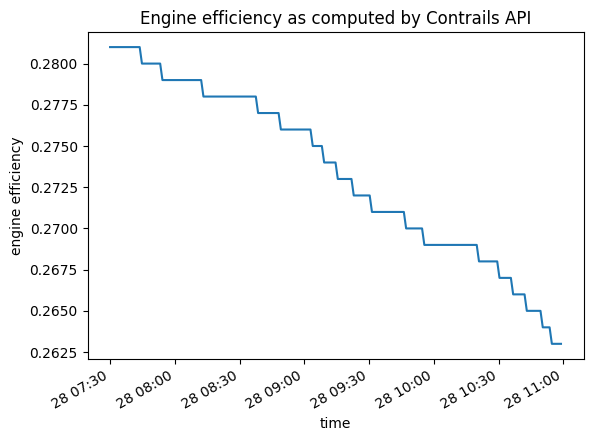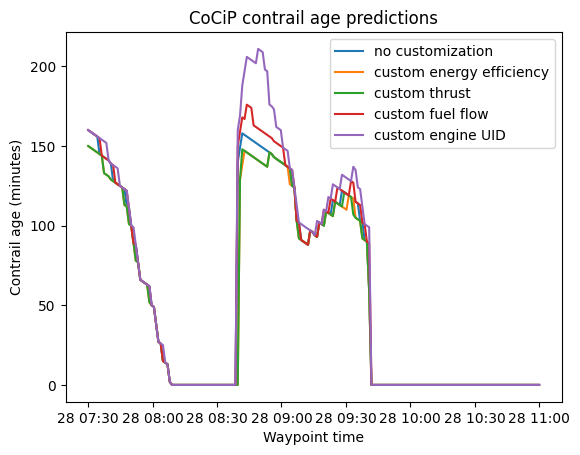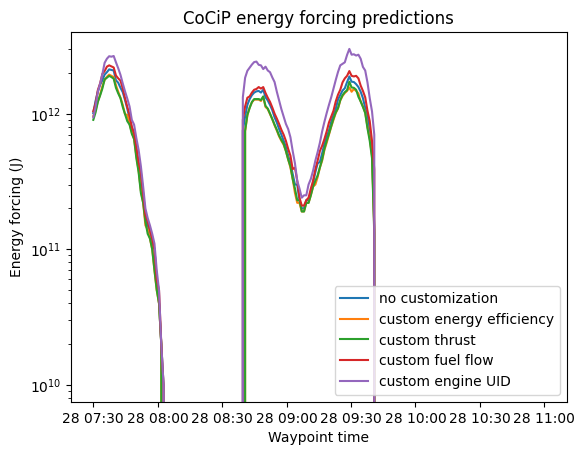Customizing Requests¶
This document walks through the process of customizing Trajectory POST requests to Contrails API. In particular, both aircraft performance input (fuel flow, engine efficiency, aircraft mass) and meteorology data may be optionally included in the request body as a way to specialize the underlying model computed in the backend. Here, we show the process of customizing requests to the /trajectory/sac and /trajectory/cocip endpoints.
See Customizable Fields for a full summary.
See Get Started to get oriented with the following topics.
Authorization
Key Validation
Trajectory API
Setup¶
Ensure you have a valid auth key configured.
[1]:
import os
import matplotlib.pyplot as plt # pip install matplotlib
import numpy as np # pip install numpy
import pandas as pd # pip install pandas
import requests # pip install requests
[2]:
# Define credentials
URL = "https://api.contrails.org"
API_KEY = os.environ["CONTRAILS_API_KEY"] # put in your API key here
HEADERS = {"x-api-key": API_KEY}
Create flight¶
Requests to /trajectory endpoints are performed via POST, with a JSON flight object in the body. A minimal flight requires four temporal-spatial fields and an ICAO aircraft type: time, longitude, latitude, altitude, and aircraft_type. If aircraft performance variables are not supplied in the request body, they are computed in API backend. Similarly, if meteorology data is not supplied in the request body, the
flight is interpolated against a gridded weather product (either ECMWF ERA5 or ECMWF HRES depending on time field of the flight).
Below we prepare a request by constructing a synthetic flight object for the POST body. This is the same approach taken in Get Started.
[3]:
n_waypoints = 200
t0 = "2022-12-28T07:30:00"
t1 = "2022-12-28T11:00:00"
flight = {
"longitude": np.linspace(-29, -50, n_waypoints).tolist(),
"latitude": np.linspace(45, 42, n_waypoints).tolist(),
"altitude": np.linspace(36000, 30000, n_waypoints).tolist(),
"time": pd.date_range(t0, t1, periods=n_waypoints).astype(int).tolist(),
"aircraft_type": "A320",
}
Custom requests to the /trajectory/sac endpoint¶
We explore the Schmidt Appleman criterion (SAC) along a flight trajectory.
A minimal request to the /trajectory/sac endpoint¶
The flight dictionary already contains all of the required fields to make a POST request.
[4]:
r = requests.post(f"{URL}/v0/trajectory/sac", json=flight, headers=HEADERS)
print(f"HTTP Response Code: {r.status_code} {r.reason}\n")
r_json = r.json()
for k, v in r_json.items():
print(f"{k}: {v}")
HTTP Response Code: 200 OK
flight_id: 1732208959759237
met_source_provider: ECMWF
met_source_dataset: ERA5
met_source_product: reanalysis
pycontrails_version: 0.52.1
humidity_scaling_name: histogram_matching
humidity_scaling_formula: era5_quantiles -> iagos_quantiles
engine_efficiency: [0.281, 0.281, 0.281, 0.281, 0.281, 0.281, 0.281, 0.281, 0.281, 0.281, 0.281, 0.281, 0.281, 0.281, 0.28, 0.28, 0.28, 0.28, 0.28, 0.28, 0.28, 0.28, 0.28, 0.279, 0.279, 0.279, 0.279, 0.279, 0.279, 0.279, 0.279, 0.279, 0.279, 0.279, 0.279, 0.279, 0.279, 0.279, 0.279, 0.279, 0.279, 0.278, 0.278, 0.278, 0.278, 0.278, 0.278, 0.278, 0.278, 0.278, 0.278, 0.278, 0.278, 0.278, 0.278, 0.278, 0.278, 0.278, 0.278, 0.278, 0.278, 0.278, 0.278, 0.278, 0.278, 0.277, 0.277, 0.277, 0.277, 0.277, 0.277, 0.277, 0.277, 0.277, 0.277, 0.276, 0.276, 0.276, 0.276, 0.276, 0.276, 0.276, 0.276, 0.276, 0.276, 0.276, 0.276, 0.276, 0.276, 0.275, 0.275, 0.275, 0.275, 0.275, 0.274, 0.274, 0.274, 0.274, 0.274, 0.274, 0.273, 0.273, 0.273, 0.273, 0.273, 0.273, 0.273, 0.272, 0.272, 0.272, 0.272, 0.272, 0.272, 0.272, 0.272, 0.271, 0.271, 0.271, 0.271, 0.271, 0.271, 0.271, 0.271, 0.271, 0.271, 0.271, 0.271, 0.271, 0.271, 0.271, 0.27, 0.27, 0.27, 0.27, 0.27, 0.27, 0.27, 0.27, 0.269, 0.269, 0.269, 0.269, 0.269, 0.269, 0.269, 0.269, 0.269, 0.269, 0.269, 0.269, 0.269, 0.269, 0.269, 0.269, 0.269, 0.269, 0.269, 0.269, 0.269, 0.269, 0.269, 0.269, 0.268, 0.268, 0.268, 0.268, 0.268, 0.268, 0.268, 0.268, 0.268, 0.267, 0.267, 0.267, 0.267, 0.267, 0.267, 0.266, 0.266, 0.266, 0.266, 0.266, 0.266, 0.265, 0.265, 0.265, 0.265, 0.265, 0.265, 0.265, 0.264, 0.264, 0.264, 0.264, 0.263, 0.263, 0.263, 0.263, 0.263, None]
sac: [1.0, 1.0, 1.0, 1.0, 1.0, 1.0, 1.0, 1.0, 1.0, 1.0, 1.0, 1.0, 1.0, 1.0, 1.0, 1.0, 1.0, 1.0, 1.0, 1.0, 1.0, 1.0, 1.0, 1.0, 1.0, 1.0, 1.0, 1.0, 1.0, 1.0, 1.0, 1.0, 1.0, 1.0, 1.0, 1.0, 1.0, 1.0, 1.0, 1.0, 1.0, 1.0, 1.0, 1.0, 1.0, 1.0, 1.0, 1.0, 1.0, 1.0, 1.0, 1.0, 1.0, 1.0, 1.0, 1.0, 1.0, 1.0, 1.0, 1.0, 1.0, 1.0, 1.0, 1.0, 1.0, 1.0, 1.0, 1.0, 1.0, 1.0, 1.0, 1.0, 1.0, 1.0, 1.0, 1.0, 1.0, 1.0, 1.0, 1.0, 1.0, 1.0, 1.0, 1.0, 1.0, 1.0, 1.0, 1.0, 1.0, 1.0, 1.0, 1.0, 1.0, 1.0, 1.0, 1.0, 1.0, 1.0, 1.0, 1.0, 1.0, 1.0, 1.0, 1.0, 1.0, 1.0, 1.0, 1.0, 1.0, 1.0, 1.0, 1.0, 1.0, 1.0, 1.0, 1.0, 1.0, 1.0, 1.0, 1.0, 1.0, 1.0, 1.0, 1.0, 1.0, 1.0, 1.0, 1.0, 0.0, 0.0, 0.0, 0.0, 0.0, 0.0, 0.0, 0.0, 0.0, 0.0, 0.0, 0.0, 0.0, 0.0, 0.0, 0.0, 0.0, 0.0, 0.0, 0.0, 0.0, 0.0, 0.0, 0.0, 0.0, 0.0, 0.0, 0.0, 0.0, 0.0, 0.0, 0.0, 0.0, 0.0, 0.0, 0.0, 0.0, 0.0, 0.0, 0.0, 0.0, 0.0, 0.0, 0.0, 0.0, 0.0, 0.0, 0.0, 0.0, 0.0, 0.0, 0.0, 0.0, 0.0, 0.0, 0.0, 0.0, 0.0, 0.0, 0.0, 0.0, 0.0, 0.0, 0.0, 0.0, 0.0, 0.0, 0.0, 0.0, 0.0, 0.0, None]
Interpret the Response¶
The response includes some descriptive information, an array of computed engine_efficiency values, and the primary output: an sac array indicating whether conditions are present at each flight waypoint for initial contrail formation.
The plot below shows SAC values along the simulated flight trajectory. Values of 1 indicate criteria for contrail formation (the SAC is satisfied). Values of 0 indicate no initial contrail formation (the SAC fails).
[5]:
flight_df = pd.DataFrame(flight).assign(sac=r_json["sac"])
flight_df["time"] = pd.to_datetime(flight_df["time"])
fig, ax = plt.subplots()
flight_df.plot.scatter("longitude", "latitude", c="sac", cmap="bwr", s=2, colorbar=False, ax=ax)
ax.set_title("SAC predictions with engine efficiency computed by Contrails API")
ax.scatter(None, None, s=2, c="r", label="SAC satisfied")
ax.scatter(None, None, s=2, c="b", label="SAC not satisfied")
ax.legend();

Backend-computed engine efficiency¶
The Schmidt-Appleman criterion requires engine efficiency as a model input. In order to handle requests such as the previous example in which no engine_efficiency is provided, the API derives it from an aircraft performance model. If calculated while fulfilling the request, engine_efficiency is also included in the response.
[6]:
flight_df = flight_df.assign(eta=r_json["engine_efficiency"])
flight_df.plot(
"time",
"eta",
title="Engine efficiency as computed by Contrails API",
ylabel="engine efficiency",
legend=False,
);

Custom engine efficiency¶
As discussed above, the /trajectory/sac endpoint relies on an aircraft performance model when engine_efficiency is not provided in request. When making requests that trigger the aircraft performance model, additional inputs such as aircraft_mass, fuel_flow, and thrust can be provided with the request. Here, we provide aircraft_mass values in the request body. This will be picked up and used in the backend aircraft performance model to compute fuel flow.
[7]:
flight_custom = {**flight, "aircraft_mass": np.linspace(72600, 64350, n_waypoints).tolist()}
r = requests.post(f"{URL}/v0/trajectory/sac", json=flight_custom, headers=HEADERS)
print(f"HTTP Response Code: {r.status_code} {r.reason}\n")
r_json_custom = r.json()
for k, v in r_json_custom.items():
print(f"{k}: {v}")
HTTP Response Code: 200 OK
flight_id: 1732208971994476
met_source_provider: ECMWF
met_source_dataset: ERA5
met_source_product: reanalysis
pycontrails_version: 0.52.1
humidity_scaling_name: histogram_matching
humidity_scaling_formula: era5_quantiles -> iagos_quantiles
engine_efficiency: [0.279, 0.279, 0.279, 0.28, 0.28, 0.28, 0.28, 0.28, 0.28, 0.28, 0.28, 0.28, 0.28, 0.28, 0.28, 0.28, 0.28, 0.28, 0.28, 0.28, 0.28, 0.28, 0.28, 0.28, 0.28, 0.28, 0.28, 0.28, 0.28, 0.28, 0.28, 0.28, 0.28, 0.28, 0.28, 0.28, 0.28, 0.28, 0.28, 0.28, 0.28, 0.28, 0.28, 0.28, 0.28, 0.28, 0.28, 0.28, 0.28, 0.28, 0.28, 0.28, 0.28, 0.28, 0.28, 0.28, 0.28, 0.28, 0.28, 0.28, 0.28, 0.28, 0.28, 0.28, 0.28, 0.28, 0.28, 0.28, 0.28, 0.28, 0.28, 0.28, 0.28, 0.28, 0.28, 0.28, 0.28, 0.28, 0.28, 0.28, 0.279, 0.279, 0.279, 0.279, 0.279, 0.279, 0.279, 0.279, 0.279, 0.279, 0.279, 0.279, 0.279, 0.278, 0.278, 0.278, 0.278, 0.278, 0.278, 0.277, 0.277, 0.277, 0.277, 0.277, 0.277, 0.277, 0.277, 0.276, 0.276, 0.276, 0.276, 0.276, 0.276, 0.276, 0.276, 0.276, 0.276, 0.276, 0.275, 0.275, 0.275, 0.275, 0.275, 0.275, 0.275, 0.275, 0.275, 0.275, 0.275, 0.275, 0.275, 0.275, 0.275, 0.275, 0.274, 0.274, 0.274, 0.274, 0.274, 0.274, 0.274, 0.274, 0.274, 0.274, 0.274, 0.274, 0.274, 0.274, 0.274, 0.274, 0.274, 0.274, 0.274, 0.274, 0.274, 0.274, 0.274, 0.274, 0.273, 0.273, 0.273, 0.273, 0.273, 0.273, 0.273, 0.273, 0.273, 0.273, 0.272, 0.272, 0.272, 0.272, 0.272, 0.272, 0.272, 0.271, 0.271, 0.271, 0.271, 0.271, 0.271, 0.27, 0.27, 0.27, 0.27, 0.27, 0.27, 0.27, 0.269, 0.269, 0.269, 0.269, 0.269, 0.268, 0.268, 0.268, 0.268, 0.268, 0.268, None]
sac: [1.0, 1.0, 1.0, 1.0, 1.0, 1.0, 1.0, 1.0, 1.0, 1.0, 1.0, 1.0, 1.0, 1.0, 1.0, 1.0, 1.0, 1.0, 1.0, 1.0, 1.0, 1.0, 1.0, 1.0, 1.0, 1.0, 1.0, 1.0, 1.0, 1.0, 1.0, 1.0, 1.0, 1.0, 1.0, 1.0, 1.0, 1.0, 1.0, 1.0, 1.0, 1.0, 1.0, 1.0, 1.0, 1.0, 1.0, 1.0, 1.0, 1.0, 1.0, 1.0, 1.0, 1.0, 1.0, 1.0, 1.0, 1.0, 1.0, 1.0, 1.0, 1.0, 1.0, 1.0, 1.0, 1.0, 1.0, 1.0, 1.0, 1.0, 1.0, 1.0, 1.0, 1.0, 1.0, 1.0, 1.0, 1.0, 1.0, 1.0, 1.0, 1.0, 1.0, 1.0, 1.0, 1.0, 1.0, 1.0, 1.0, 1.0, 1.0, 1.0, 1.0, 1.0, 1.0, 1.0, 1.0, 1.0, 1.0, 1.0, 1.0, 1.0, 1.0, 1.0, 1.0, 1.0, 1.0, 1.0, 1.0, 1.0, 1.0, 1.0, 1.0, 1.0, 1.0, 1.0, 1.0, 1.0, 1.0, 1.0, 1.0, 1.0, 1.0, 1.0, 1.0, 1.0, 1.0, 1.0, 0.0, 0.0, 0.0, 0.0, 0.0, 0.0, 0.0, 0.0, 0.0, 0.0, 0.0, 0.0, 0.0, 0.0, 0.0, 0.0, 0.0, 0.0, 0.0, 0.0, 0.0, 0.0, 0.0, 0.0, 0.0, 0.0, 0.0, 0.0, 0.0, 0.0, 0.0, 0.0, 0.0, 0.0, 0.0, 0.0, 0.0, 0.0, 0.0, 0.0, 0.0, 0.0, 0.0, 0.0, 0.0, 0.0, 0.0, 0.0, 0.0, 0.0, 0.0, 0.0, 0.0, 0.0, 0.0, 0.0, 0.0, 0.0, 0.0, 0.0, 0.0, 0.0, 0.0, 0.0, 0.0, 0.0, 0.0, 0.0, 0.0, 0.0, 0.0, None]
Compare the responses¶
As shown below, supplying a custom aircraft mass gives rise to different engine efficiency and therefore different SAC predictions.
[8]:
fig, ax = plt.subplots()
ax.plot(flight_df["time"], r_json["engine_efficiency"], label="minimal request")
ax.plot(
flight_df["time"],
r_json_custom["engine_efficiency"],
label="request with custom aircraft mass",
)
ax.set_ylabel("engine efficiency")
ax.set_title("Comparing engine efficiency with and without custom aircraft mass")
ax.legend();

Bypass Contrails API’s aircraft performance model¶
Engine efficiency can itself be provided directly with the request, in which case the aircraft performance model is not used in the backend. For the SAC model, any additional aircraft_mass, fuel_flow, and thrust are not used (they are only used as inputs to the aircraft performance model).
Here, we provide engine_efficiency with the request, using values that are 80% of those computed by and returned in the first request.
Note: Currently,
engine_efficiencyvalues returned by the API have an undefined value at the terminal trajectory waypoint. In the cell below, we forward fill theengine_efficiencyat the last waypoint.
[9]:
eta = [0.8 * e for e in r_json["engine_efficiency"][:-1]]
eta.append(eta[-1]) # fill the nan value
flight_custom = {**flight, "engine_efficiency": eta}
r = requests.post(f"{URL}/v0/trajectory/sac", json=flight_custom, headers=HEADERS)
print(f"HTTP Response Code: {r.status_code} {r.reason}")
r_json_custom = r.json()
HTTP Response Code: 200 OK
[10]:
flight_df_custom = pd.DataFrame(flight_custom).assign(sac=r_json_custom["sac"])
fig, (ax1, ax2) = plt.subplots(ncols=2, figsize=(8, 4))
flight_df.plot.scatter("longitude", "latitude", s=2, c="sac", cmap="bwr", ax=ax1, colorbar=False)
flight_df_custom.plot.scatter(
"longitude", "latitude", s=2, c="sac", cmap="bwr", ax=ax2, colorbar=False
)
ax1.set_title("SAC state, engine efficiency computed with Contrails API")
ax2.set_title("SAC state, custom engine efficiency")
for ax in [ax1, ax2]:
ax.scatter(None, None, s=2, c="r", label="SAC satisfied")
ax.scatter(None, None, s=2, c="b", label="SAC not satisfied")
ax.legend()
plt.tight_layout();

Note the higher incidence of initial contrails associated with higher engine efficiency values. This is expected.
Custom meteorology¶
Meteorological conditions used to calculate SAC are derived from ECMWF ERA5 data. Custom meteorology can be provided with the requests. Meteorology fields include air_temperature and specific_humidity. See Customizable Fields for more details.
Here, we include custom specific humidity data in the request and compare the results.
[11]:
q = np.linspace(0.0000067, 0.0001148, n_waypoints).tolist()
flight_humid = {**flight_custom, "specific_humidity": q}
r = requests.post(f"{URL}/v0/trajectory/sac", json=flight_humid, headers=HEADERS)
print(f"HTTP Response Code: {r.status_code} {r.reason}")
r_json_humid = r.json()
flight_df_humid = pd.DataFrame(flight_humid).assign(sac=r_json_humid["sac"])
fig, (ax1, ax2) = plt.subplots(ncols=2, figsize=(8, 4))
flight_df.plot.scatter("longitude", "latitude", s=2, c="sac", cmap="bwr", ax=ax1, colorbar=False)
flight_df_humid.plot.scatter(
"longitude", "latitude", s=2, c="sac", cmap="bwr", ax=ax2, colorbar=False
)
ax1.set_title("SAC for ERA5-derived specific humidity")
ax2.set_title("SAC for custom specific humidity")
for ax in [ax1, ax2]:
ax.scatter(None, None, s=2, c="r", label="SAC satisfied")
ax.scatter(None, None, s=2, c="b", label="SAC not satisfied")
ax.legend()
plt.tight_layout();
HTTP Response Code: 200 OK

Custom requests to the /trajectory/cocip endpoint¶
We make five separate requests to the /trajectory/cocip endpoint, each with different custom aircraft performance data.
Fleet computation is not currently equipped to handle flight data with different input fields. Consequently, we make five separate requests to
/trajectory/cocipinstead of a single fleet request.
Engine specialization¶
The engine_uid field is used to query the ICAO Aircraft Engine Emissions Databank. If known, it should be provided with the request. If not, the API will attempt to match the aircraft_type to an engine in the databank. See the Default Engine Table for a default mapping of aircraft types to engines.
[12]:
r = requests.post(f"{URL}/v0/trajectory/cocip", json=flight, headers=HEADERS)
print(f"HTTP Response Code: {r.status_code} {r.reason}")
r_json_no_customization = r.json()
HTTP Response Code: 200 OK
[13]:
payload = {**flight, "engine_efficiency": np.linspace(0.35, 0.31, n_waypoints).tolist()}
r = requests.post(f"{URL}/v0/trajectory/cocip", json=payload, headers=HEADERS)
print(f"HTTP Response Code: {r.status_code} {r.reason}")
r_json_custom_ee = r.json()
HTTP Response Code: 200 OK
[14]:
payload = {**flight, "thrust": np.linspace(25000, 30000, n_waypoints).tolist()}
r = requests.post(f"{URL}/v0/trajectory/cocip", json=payload, headers=HEADERS)
print(f"HTTP Response Code: {r.status_code} {r.reason}")
r_json_custom_thrust = r.json()
HTTP Response Code: 200 OK
[15]:
payload = {**flight, "fuel_flow": 0.65} # use a scalar value for the entire trajectory
r = requests.post(f"{URL}/v0/trajectory/cocip", json=payload, headers=HEADERS)
print(f"HTTP Response Code: {r.status_code} {r.reason}")
r_json_custom_ff = r.json()
HTTP Response Code: 200 OK
[16]:
payload = {**flight, "engine_uid": "01P10IA019"} # override the assumed engine UID
r = requests.post(f"{URL}/v0/trajectory/cocip", json=payload, headers=HEADERS)
print(f"HTTP Response Code: {r.status_code} {r.reason}")
r_json_custom_engine = r.json()
HTTP Response Code: 200 OK
Visualize responses¶
Providing custom aircraft performance data does change CoCiP model output. Below we plot contrail age and energy forcing predictions.
[17]:
fig, ax = plt.subplots()
ax.plot(flight_df["time"], r_json_no_customization["contrail_age"], label="no customization")
ax.plot(flight_df["time"], r_json_custom_ee["contrail_age"], label="custom energy efficiency")
ax.plot(flight_df["time"], r_json_custom_thrust["contrail_age"], label="custom thrust")
ax.plot(flight_df["time"], r_json_custom_ff["contrail_age"], label="custom fuel flow")
ax.plot(flight_df["time"], r_json_custom_engine["contrail_age"], label="custom engine UID")
ax.legend()
ax.set_title("CoCiP contrail age predictions")
ax.set_ylabel("Contrail age (minutes)")
ax.set_xlabel("Waypoint time");

[18]:
fig, ax = plt.subplots()
ax.plot(flight_df["time"], r_json_no_customization["energy_forcing"], label="no customization")
ax.plot(flight_df["time"], r_json_custom_ee["energy_forcing"], label="custom energy efficiency")
ax.plot(flight_df["time"], r_json_custom_thrust["energy_forcing"], label="custom thrust")
ax.plot(flight_df["time"], r_json_custom_ff["energy_forcing"], label="custom fuel flow")
ax.plot(flight_df["time"], r_json_custom_engine["energy_forcing"], label="custom engine UID")
ax.legend()
ax.set_title("CoCiP energy forcing predictions")
ax.set_ylabel("Energy forcing (J)")
ax.set_yscale("log")
ax.set_xlabel("Waypoint time");

Customizable Fields¶
If known, the engine_uid should be provided with the request. See our table of default values for a mapping of aircraft types to engines.
A table of additional customizable fields is shown below. See Contrails API Schemas for details on each the aircraft performance fields, including descriptions and units of measure.
|
Aircraft performance fields |
Meteorology fields |
|---|---|---|
|
|
|
|
(none) |
|
|
(same as |
(same as |
|
(same as |
(same as |
|
|
|
|
(same as |
(same as |
* Unused if engine_efficiency is also provided
** Currently, met can only be customized on first step of CoCiP
Best practices¶
If any aircraft performance is known along a flight trajectory, it should be supplied with the
/trajectoryrequest for more precise predictions.If meterology is known along a flight trajectory, it can be supplied with the
/trajectoryrequest. The CoCiP model employs an iterative contrail evolution. Consequently, the/trajectory/cocipendpoint will only use custom meteorology data in the initial step. Customizing meteorology should be consider experimental.